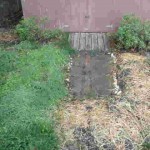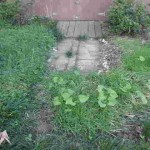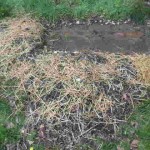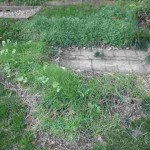



This is how I repaired a long term dead patch of lawn with swales built hugelkulutr style. New Growth in just 3 weeks! This used to be an unsightly ugly dead patch of nothing. Everything green now used to be just plain old dead dirt. The right soil mix, the right seeds, hugelkultur and the right amount of
water catch and store and behold. Life where I couldn’t green anything for three years. Listen to the podcast for more.
Bring Life To Dead Patch Of Lawn – An Update On Hugelkultur And Swales
- A follow up to Episode-95 and Permaculture Principle #8- Integrate Rather Than Segregate – “Many hands make light work”. By putting the right things in the right place, relationships develop between those things and they work together to support each other. Every attempt for three years repair the dead patches in my yard ended in failure as there was never enough soil or lawn started to hold back the water run off and erosion. My experimenting and success with hugelkultur this year fostered a change in my approach to how I think and plan for bringing life to my land. The dead patches were dead not because they lacked artificial fertilizer and grass seed but rather my land is clay and quartz rock and what the hell can grow on that other than nothing?
- As I have been learning more about permaculture and gardening, soil improvement and compost I have become more adept at adjusting to the challenges that my yard and gardens have posed. Wood that is covered with soil serves to catch and hold water and break down slowly enough over time to allow for nutrient dispersal, and bacterial growth which then fosters a gathering and flourishing of life such as worms, and other insects that help to till and fertilize the clay soil to an amazing degree of productivity.
- My son and I dug out the dead patches to a depth of at least 6 inches. Then I tossed in small logs and branches, covered them with compost and top soil. This raised the level of the ground and in built swales to catch and hold water, which is necessary because the dead patches were all located in my backyard which slopes steeply to the northwest corner of the yard.
- The cost for doing these fixes was really one of time and energy versus cost. I only used top soil I could scrounge from near the fence line which is covered with trees, my homegrown compost, logs and other pieces of wood from yard and seeds I had leftover from other plantings.
- Not only is this method more beautiful but it has opened my eyes to what really makes things green and it’s not the petro chemicals sold in stores. It’s the life and breakdown of that life and creation of new life in the form of bacteria, insects, animals and plants that give off carbon in various forms and that carbon is basic building block of all life on planet earth. I have taken this approach to fixing other dead patches and I will be reporting about the changes this has created in my landscape for the better.
Resources
- Episode-95- How To Green A Dead Patch Of Lawn Or Permaculture Principle #8
- Episode-87- Low Cost Lawn And Garden Care or Permaculture Principle #5
- Episode-61- Build A Dream – Gaia’s Garden – Book Review
- Jack Spirko – Building an A-Frame Level – The Hugelkultur Project Part 3
Song of The Day – Carl Ditters von Dittersdorf – MP3 Sinfonia in D major, TWV 44:1: III. Vivace – Video
